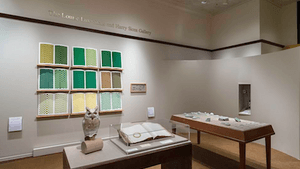Stay in the Loop
BSR publishes on a weekly schedule, with an email newsletter every Wednesday and Thursday morning. There’s no paywall, and subscribing is always free.
Art inspired by the history of the blind
'Common Touch' at the Library Company of Philadelphia

“Please touch, and you may want to close your eyes.”
This is the Library Company of Philadelphia’s (LCP) uncommon instruction for Common Touch. In this exhibition, artist/curator Teresa Jaymes considers the experience of the blind and visually impaired through art and artifact.
Making blindness visceral
Try as we might to imagine it, closing our eyes in well-known rooms, we can’t replicate the challenge of blindness, of reading and writing, following a musical score, doing math, or plotting directions on a map. Common Touch makes these tasks tangible, tracing the evolution of educational methods and printing through documents and objects.
Jaymes, who uses archival material as inspiration, worked with LCP’s extensive collection related to the blind and visually impaired for almost five years. She has distilled that experience into a few artworks, which are displayed with the items and personal histories that inspired them.
Each encounter is layered, and slower viewing is worthwhile.
Evolution of literacy tools
Gift #2 (2016), a felt field with foot-high cutouts for curving metal letters, is an enlargement of the painstaking script of Jennie Partridge, a 19th century student at what is now Perkins School of the Blind in Boston. Her correspondence is displayed nearby with teaching tools: A wooden writing guide, pushpins for raised-dot printing, and an 1838 sample of raised-letter printing.
In raised-letter printing, letters are pressed into paper but not inked, and the result was thought a workable compromise, accessible to sighted and visually impaired readers alike. Some of the earliest such documents were produced by the Pennsylvania Institute for the Instruction of the Blind, now Overbrook School for the Blind. But raised-letter publications require more paper, and could not be read by users whose sense of touch had diminished with age or manual labor.
Exploring the world without sight
Two works were inspired by John Metcalf, known as Blind Jack of Knaresborough, a surveyor in 18th century England and in his youth, something of a rascal. Metcalf ultimately built more than 180 miles of roads in Yorkshire, and would have learned geography as blind children did, with pins, screws, and plaster articulating territorial features. His remarkable story led Jaymes to create Gift #5 (2016), a tabletop map, and Common Sense’s most remarkable piece, Gift #6 (2016), produced with the assistance of the Monell Chemical Senses Center.
Gift #5 is an oblong table with a cushioned linen top, divided by colored strands of yarn. Each color denotes a type of landscape: woods, moors, and so on. Pale green porcelain shapes indicate topographical features such as hollows, slopes, summits and ridges. Fingering the piece, you wonder how Metcalf could possibly have kept track of such details, or even traversed untamed territory in the first place.
Virtual reality through smell and sound
Near the map is Gift #6, an olfactometer, in which a headset and funnel project from a wall. Visitors are instructed to put the headset on, angle the funnel toward the face, push a button, and to heighten the effect, close their eyes. The results are dreamlike.
In the first vignette, you’re in an audience. You feel the draft of people moving nearby, catching fragrances and murmured apologies as seats are taken. The pianist tunes up. Concertgoers settle, feet shuffle on a wooden floor. Applause. The music begins, and the scene drifts away.
Vignette two recreates one of Metcalf’s youthful exploits, in which he “borrowed” a pack of hunting dogs from a neighbor. You’re outside. The air smells fresh, green, and feels moist, as in early morning. A horse snorts, a saddle creaks. There’s a whistle, and a panting dog approaches, then hoofbeats, moderately fast. You hear more dogs, both near and far. Now you’re galloping, and the scene dissolves.
Cases in a back gallery delve deeper, tracing the “war of the dots,” the reconciliation of raised-dot writing systems into Standard English Braille, which since 1932 has dominated in the United States.
Spend time
As a participant in last month’s PoliticalFest, LCP saw hundreds more visitors than usual. The hurried crowds came to see Thomas Jefferson’s edits (incredibly tiny, very legible), photos of previous conventions, and voting artifacts, and it’s unlikely they gave Common Touch the attention it deserves. With the politicos gone, the rest of us have until October 21. Hurry to take in Common Touch, but once there, take your time.
To read Stephen Silver’s review of PoliticalFest, click here.
What, When, Where
Common Touch, The Art of the Senses in the History of the Blind. Through October 21, 2016 at the Library Company of Philadelphia, 1314 Locust St., Philadelphia. (215) 546-3181 or librarycompany.org.
Sign up for our newsletter
All of the week's new articles, all in one place. Sign up for the free weekly BSR newsletters, and don't miss a conversation.
